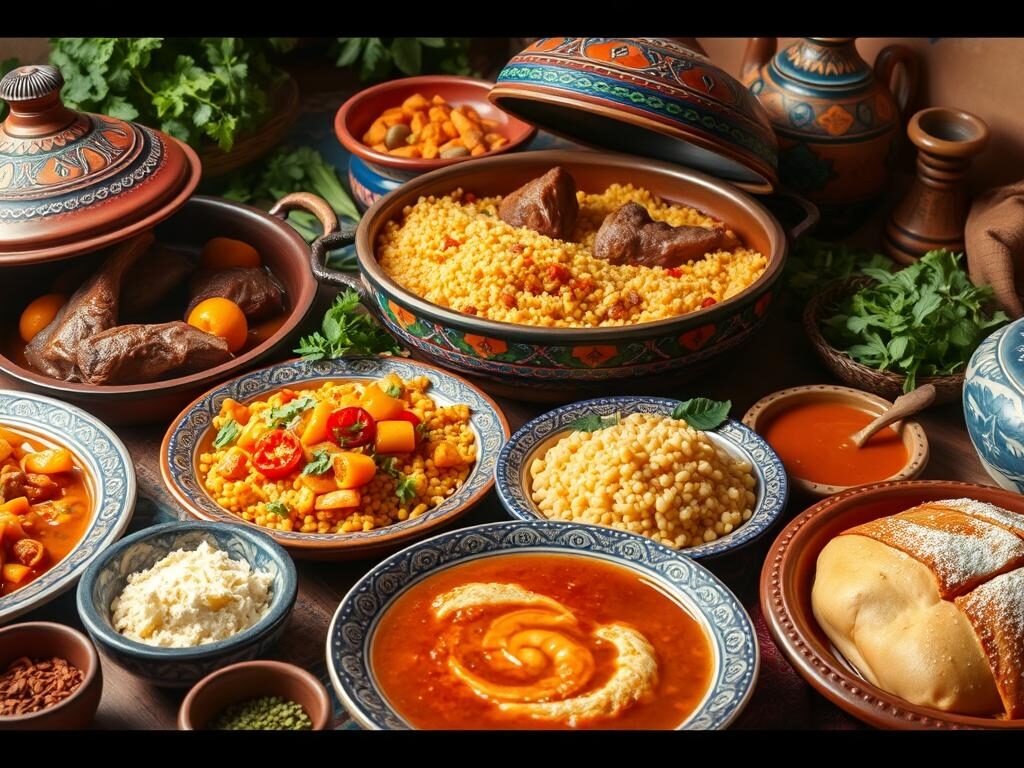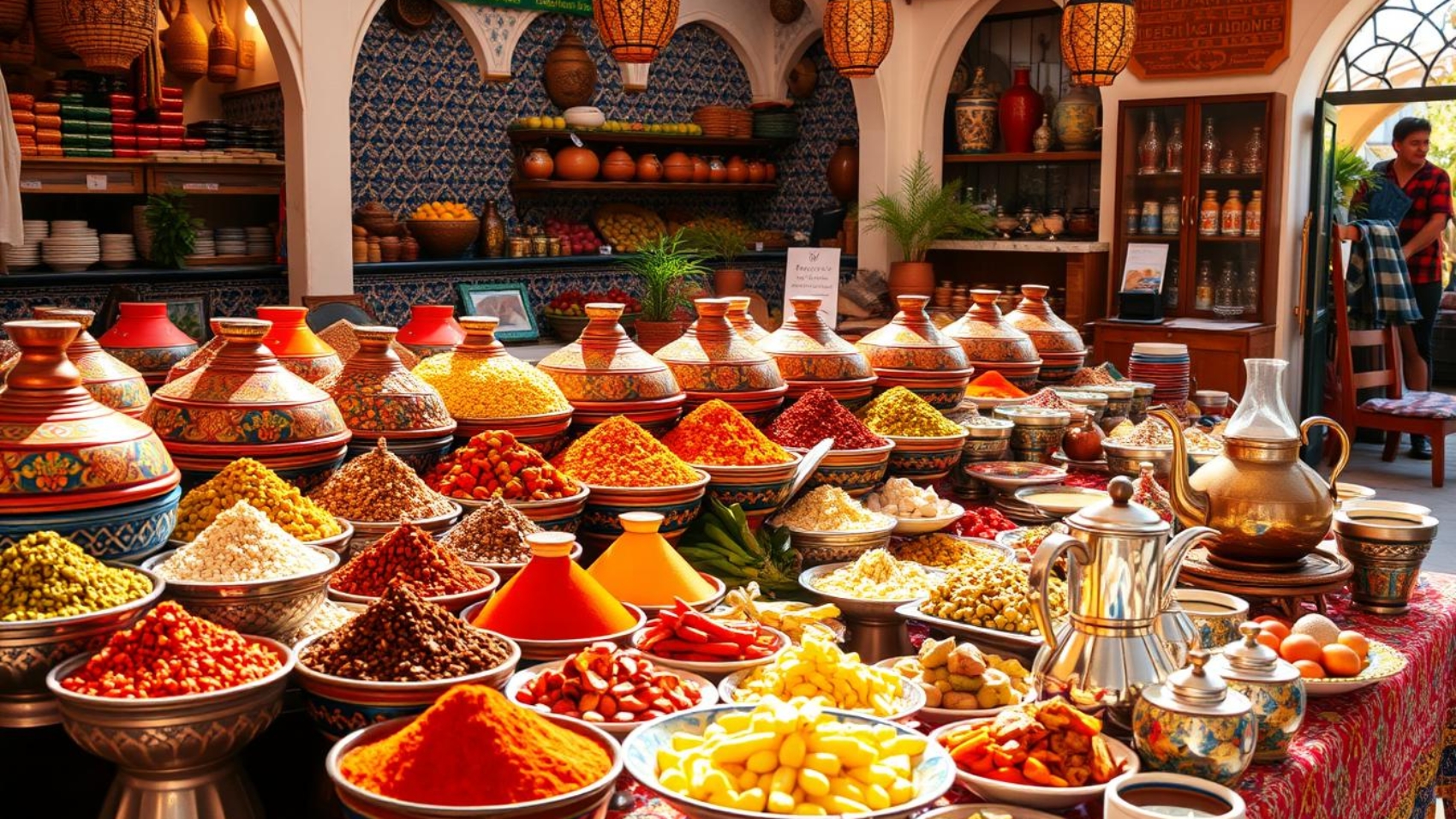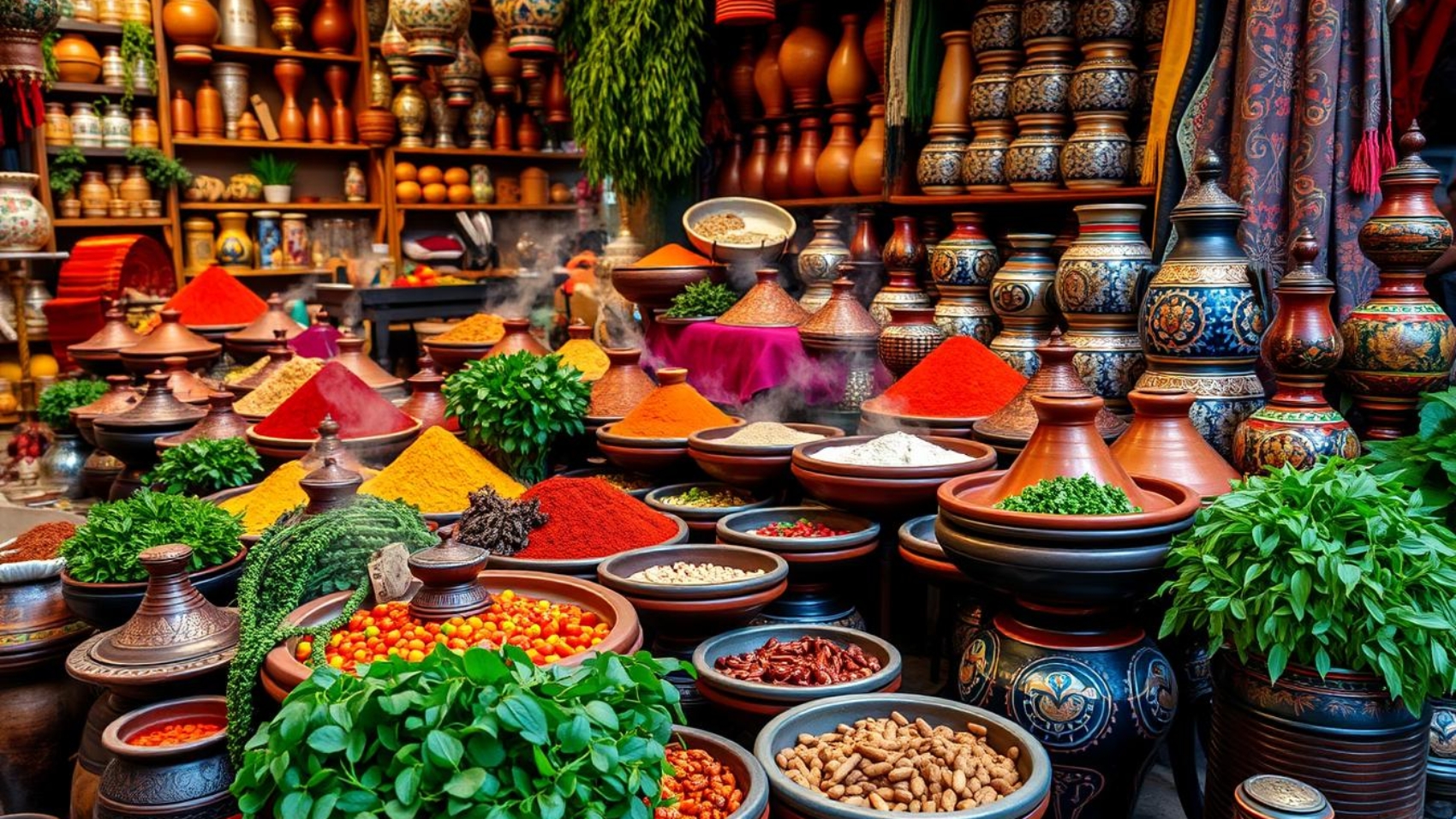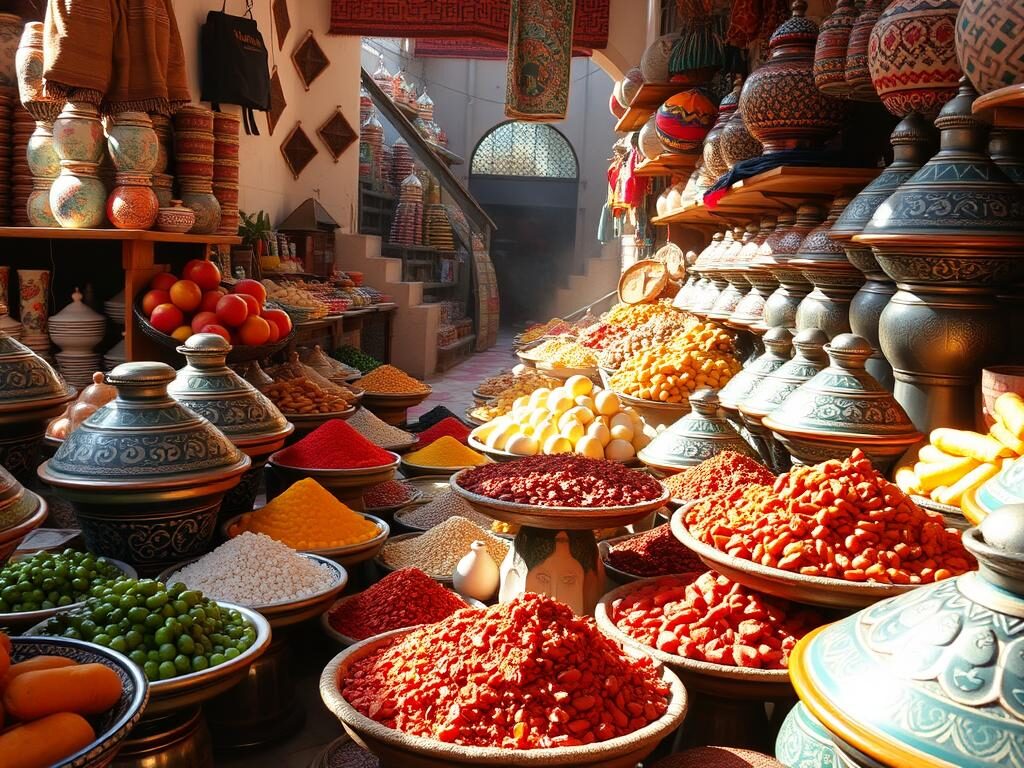Moroccan food in Morocco is a thrilling journey through history and tradition. It combines spices, local ingredients, and cultural influences in a unique way. This creates a variety of dishes that excite the senses.
From the fragrant tagines to the light couscous, Moroccan flavors show its rich heritage. Each meal is a celebration of community and culture.
Introduction to Moroccan Culinary Heritage
Moroccan culinary heritage is a vibrant mix of cultures and traditions. It shows a blend of Berber, Arab, and French cuisines. Each adds unique flavors and techniques to Moroccan food.
Morocco’s geography greatly influences its food. The country has mountains, coastlines, and deserts. These areas provide a wide range of local ingredients.
Cooking in Morocco combines different cultural practices. Dishes like tajine emphasize communal meals. This shows how Moroccan cooking has evolved while keeping traditions alive.
Delving into Moroccan culinary heritage is more than just tasting food. It’s about understanding the stories and cultural importance behind each dish. Every bite tells a piece of Morocco’s complex history and its people’s identity.
Exploring Moroccan Food Culture
Moroccan food culture is all about community, hospitality, and sharing meals. Social dining in Morocco is key, bringing people together for food and talk. Family meals are filled with shared dishes, strengthening family and friendship ties.
Mealtime is more than eating; it’s about being together. This is especially true during celebrations and festivals.
Social Aspects of Dining
In Morocco, dining is a sign of hospitality. Guests are welcomed with open arms, and meals are often big and shared. This creates a bond between diners, making memories that last.
Family meals are grand, with dishes from all over Morocco. They show off the best of the region and what’s in season.
Global Influences on Moroccan Cuisine
Moroccan food has changed over time, thanks to global flavors. Mediterranean and Sub-Saharan ingredients have added new tastes. This mix has made Moroccan food exciting and diverse.
Today, chefs are pushing the boundaries of Moroccan cuisine. They mix old recipes with new cooking methods. This has changed Moroccan food culture for the better.
This new cuisine is a celebration of Morocco’s unique flavors in our global world.
Traditional Moroccan Dishes You Must Try
Exploring Morocco’s national dish opens a world of flavors. Couscous is a key dish, more than food; it’s a cultural symbol. It’s made with steamed grains, mixed with vegetables, meats, and spices. The way it’s made varies, showing the diversity of Moroccan cooking.
At special times, couscous is a big part of gatherings. It’s made in large amounts to share with family and friends.
Couscous: The National Dish
Couscous is Morocco’s national dish, bringing people together. It’s steamed to be light and fluffy. There are many ways to make it, like:
- Couscous with lamb: A hearty dish, often with spices and almonds.
- Vegetable couscous: A vegetarian option with fresh vegetables.
- Couscous with raisins: A sweet version that’s a perfect balance of flavors.
This dish suits many diets, showing its flexibility. It’s a symbol of Moroccan meals, where food brings people together.
Tajine: More Than Just a Pot
The tajine is a cooking pot and a favorite Moroccan dish. It cooks food slowly, blending flavors into rich meals. You can find tajines with chicken, fish, or beef, like:
- Chicken and preserved lemon tajine: A classic that shows off Moroccan flavors.
- Beef with prunes tajine: A mix of savory and sweet.
- Vegetable tajine: A flexible dish with seasonal produce and spices.
Tajine combines traditional ingredients with unique spices. It shows the balance of flavors in Moroccan cooking.
Moroccan Food in Morocco: A Culinary Adventure
Exploring Moroccan food in Morocco is a thrilling journey for food lovers and travelers. From Marrakech’s lively markets to Essaouira’s calm coasts, the country offers a wide range of culinary experiences. These experiences highlight Morocco’s rich heritage.
Street food tours show the true spirit of Moroccan culture. You’ll find stalls with delicious treats like crispy briouates, savory sardines, and refreshing mint tea. Each bite tells a story, giving you a taste of local traditions and flavors.
Regional specialties add to the excitement of travel and cuisine in Morocco. The mountains are home to hearty tagines, while coastal cities offer fresh seafood with local spices. Dining out becomes a celebration of flavors.
But cooking these dishes at home adds another layer of connection to the culture. Many visitors enjoy making their favorite Moroccan recipes. They turn their kitchens into a tribute to the delicious culinary heritage they discovered on their travels.
Famous Moroccan Recipes to Cook at Home
Exploring famous Moroccan recipes opens a door to the rich flavors of Moroccan cuisine. Two dishes are especially loved: harira soup and pastilla. Let’s look at what makes them special, how to make them, and the joy they bring to meals.

Spicy Harira Soup
Harira soup is a must-try for those who love traditional Moroccan cuisine. It’s known for its hearty mix of tomatoes, lentils, chickpeas, and spices. This soup is a big deal during Ramadan, when it’s enjoyed to break the fast.
Harira soup has different versions in different places. Each one adds its own twist, making it even more authentic.
Sweet and Savory Pastilla
Pastilla is a beloved Moroccan pastry that combines sweet and savory flavors. It’s made with layers of thin pastry, filled with pigeon or chicken, nuts, and spices. The way it’s made shows off Moroccan culinary art.
Pastilla has a rich history, dating back to royal times. It’s a dish that celebrates and brings people together.
Best Places to Eat in Morocco
Exploring Morocco’s food scene is a memorable adventure. Whether you’re looking for the best places to eat in Morocco or top Moroccan restaurants, Marrakech is the place to be. The city offers a wide range of dining experiences, from cozy spots to lively eateries. Each place has its own unique atmosphere, dishes, and reviews that showcase the heart of Moroccan cuisine.
Top Moroccan Restaurants in Marrakech
Several restaurants in Marrakech are known for their outstanding food and authentic Moroccan flavors. They create a welcoming atmosphere that makes dining in Marrakech special. Some of the top spots include:
- Le Tobsil – A hidden gem in the medina, it’s famous for its traditional decor and delicious tajine dishes.
- Al Fassia – Known for its tasty lamb dishes and excellent service, this restaurant serves homemade Moroccan food.
- Dar Yacout – A well-known dining spot with stunning views, it offers a multi-course meal that captures Marrakech’s essence.
Local Eateries to Experience Authenticity
Local eateries in Morocco offer genuine flavors and experiences. These spots not only serve delicious food but also let you connect with Moroccan culture and people. Some local favorites include:
- Snack Aicha – A favorite among locals for its tasty tagines and cozy atmosphere.
- La Table de Marrakech – Focuses on fresh, farm-to-table ingredients, highlighting true Moroccan hospitality.
- Chez Chegrouni – Great for casual dining, it’s known for its flavorful couscous and relaxed vibe.
Moroccan Street Food: A Tasty Exploration
Exploring Moroccan street food is a treat for the senses. It’s filled with flavors and aromas that are hard to resist. You’ll find everything from sizzling kebabs to fluffy beghrir, each with its own story.
Street vendors in Morocco offer a feast that’s both accessible and deeply rooted in community and heritage. It’s a true reflection of the local culture.
Must-Try Street Foods
As you wander the bustling streets, you’ll come across some local specialties that are a must-try:
- Kebabs: Succulent pieces of marinated meat grilled to perfection, often served with fresh bread.
- Brochettes: Skewered meat with vibrant spices, a perfect quick bite during daytime strolls.
- Beghrir: Moroccan pancakes with tiny holes, ideal for pairing with honey or jam.
Where to Find the Best Street Vendors
Morocco’s cities are full of street food hotspots. Visitors can easily find these delights in various places. Here are some top spots:
- Marrakech’s Djemaa el-Fna: A vibrant square filled with numerous vendors offering diverse food options.
- Fez’s local food markets: A treasure trove for traditional dishes, providing an authentic taste of Moroccan culture.
- Casablanca’s waterfront stalls: Perfect for enjoying flavorful seafood prepared on the spot.
The Art of Moroccan Spices
Moroccan cuisine is famous for its rich flavors. This is thanks to the special mix of spices used. Spices like cumin, coriander, saffron, and ras el hanout make Moroccan food unique. Each spice adds its own taste to Moroccan dishes.
Common Spices Used in Moroccan Cooking
In Moroccan kitchens, many spices are key:
- Cumin: This spice brings warmth and earthiness, often used in fish and meat dishes.
- Coriander: With its citrus notes, coriander brightens up stews and tagines.
- Saffron: Known for its luxurious flavor and color, saffron enhances rice dishes and tagines.
- Ras el Hanout: This complex blend can contain up to 10 different spices, contributing to various signature Moroccan dishes.
These spices weave together to show Morocco’s rich culinary history.
How Spices Enhance Flavor
Spices can make a dish taste better. They add warmth and zest, and are good for health. Finding the right mix of spices is key in Moroccan cooking.
Knowing how to pair flavors is important in Moroccan cooking. Mixing sweet with savory or hot with cool makes dishes exciting. This skill lets chefs create meals that are both tasty and uniquely Moroccan.
Preparing for Your Moroccan Culinary Experience
Trying Moroccan cuisine is more than just eating tasty food. It’s about diving into a world of flavors, traditions, and shared moments. When you go to a Moroccan meal, get ready for a fun trip through the country’s lively culture.
What to Expect from a Moroccan Meal
A Moroccan meal has many courses that excite your taste buds. You’ll start with salads, then enjoy traditional tagines and big bowls of couscous. The dishes are full of flavor, thanks to the spices.
Everyone shares the food, which brings people together. This sharing is key to the Moroccan dining experience. It helps create bonds among those eating.
Dining Etiquette in Morocco
Knowing how to dine in Morocco makes your meal even better. Meals often mean sharing food from a big dish. This shows the value of community.
It’s polite to eat with your right hand. Using utensils is okay too. But, trying the food with your hands makes you feel closer to the meal. Enjoying the flavors and following these customs will make your experience unforgettable.
Culinary Tours: A Deeper Dive into Moroccan Cuisine
Exploring Moroccan cuisine through culinary tours in Morocco is a unique experience. These tours take you to local markets, where you can learn to cook and taste different dishes. You’ll get to see the vibrant markets and smell the spices, making for unforgettable moments.
Recommended Culinary Experiences
Culinary tours in Morocco offer a wide range of activities. Here are some top picks:
- Market Visits: You’ll go on guided walks through busy souks. Here, you’ll learn about local ingredients and seasonal produce.
- Tastings: Many tours include tasting sessions at famous local eateries. You’ll get to try various traditional dishes.
- Food Pairing Sessions: Some tours teach you about wine and food pairings. You’ll learn how to enhance Moroccan flavors.
Cooking Classes to Join
For a deeper dive, consider joining cooking workshops. These classes teach you how to make traditional Moroccan dishes. You can choose from full-day sessions to multi-day courses for a full cultural immersion. Here’s what you can expect:
- Learn to Cook Moroccan Food: Classes focus on key techniques for making dishes like tagines and couscous.
- Discover Culinary Traditions: Instructors share stories behind the dishes, adding depth to your learning.
- Participate in Cultural Events: Some workshops let you join in local celebrations. This gives you a true glimpse into Moroccan culture.
Conclusion
The journey through Moroccan food in Morocco is full of flavors, traditions, and stories. The culinary heritage shows the rich history of this place. It invites you to enjoy each dish, knowing its roots.
From couscous to tajine, these dishes show the heart of Moroccan dining. They bring people together and show the warmth of Moroccan hospitality.
Trying these traditional dishes opens your mind to the Moroccan way of life. It connects you with the local culture, making your travels richer. Whether it’s eating at a local place or taking a cooking class, Moroccan food teaches you about its traditions.
Enjoying Moroccan food is more than just eating. It’s a chance to learn the stories behind each meal. Every bite tells a part of Morocco’s history, and every flavor shows the love of its people.
FAQ
What are some traditional dishes I should try in Morocco?
You should try couscous, tajine, and harira soup. These dishes show off Morocco’s unique flavors and cooking ways.
Where can I find the best places to eat Moroccan food?
Top spots for Moroccan food are in Marrakech and Fez. These cities have restaurants known for their authentic dishes and lively atmosphere. Don’t miss local eateries for a real taste of Morocco.
What is Moroccan street food like?
Moroccan street food is a tasty mix of local treats. You’ll find kebabs, brochettes, and beghrir (Moroccan pancakes). Street vendors in Marrakech offer these affordable, authentic snacks.
How has global cuisine influenced Moroccan food?
Moroccan food has been shaped by many cultures, especially the Mediterranean and Sub-Saharan. This mix has brought new twists to traditional dishes, making Moroccan food even more diverse.
Can you recommend a famous Moroccan recipe to cook at home?
Try making pastilla, a Moroccan pastry with sweet and savory flavors. It’s a traditional recipe that brings a taste of Morocco into your kitchen.
What dining etiquette should I follow in Morocco?
When eating in Morocco, respect local customs. Share food, use your right hand, and appreciate the meal. Knowing these customs makes your dining experience better.
What can I expect from a typical Moroccan meal?
Moroccan meals are full of flavors and served in a communal way. You’ll enjoy many dishes, showing the variety of Moroccan food.
Are there cooking classes available for learning Moroccan cuisine?
Yes, Morocco has many cooking classes. They teach you to make classic dishes and often include market visits. It’s a great way to learn about Moroccan cooking traditions.




